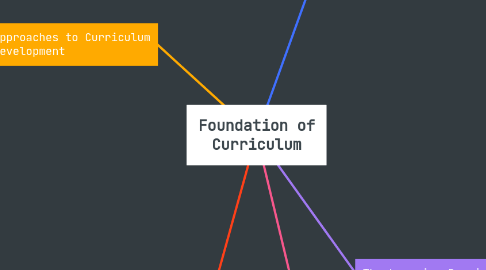
1. Approaches to Curriculum Development
1.1. Curriculum planning
1.1.1. identify the strengths and weakness of the existing curriculum
1.2. Curriculum design
1.2.1. Theories of learning
1.2.2. Child development
1.2.3. five models of curriculum design
1.2.3.1. The objectives model
1.2.3.2. The process model
1.2.3.3. Tyler’s model
1.2.3.4. Wheeler’s model
1.2.3.5. Kerr’s model
1.2.4. Horizontal Alignment
1.2.5. Vertical Alignment
1.3. Curriculum implementation
1.3.1. Factors that influence the curriculum implementation
1.3.1.1. Teacher
1.3.1.2. Learners
1.3.1.3. Resource Materials and Facilities
1.3.1.4. Stakeholders
1.3.1.5. The School Environment
1.3.1.6. Culture and Ideology
1.3.1.7. Instructional Supervision
1.3.1.8. Assessment
1.4. Curriculum evaluation
1.4.1. Forms of Evaluation
1.4.1.1. Summative
1.4.1.2. Formative
2. Curriculum, Instruction and Assessment in the Context of Curriculum
2.1. Curriculum
2.1.1. what to know
2.2. Instruction
2.2.1. methods
2.2.2. learning activities
2.3. Assessment
2.3.1. measure
2.3.1.1. Formative
2.3.1.2. Summative
3. Concepts of Curriculum
3.1. Types of curriculm
3.1.1. Formal Curriculum
3.1.1.1. selected written programs and contents
3.1.2. Informal Curriculum
3.1.2.1. curriculum in use
3.1.3. Actual Curriculum
3.1.4. Core Curriculum
3.1.5. Extra-Mural Curriculum
3.1.6. Hidden/Collateral Curriculum
3.2. Three Levels of Curriculum
3.2.1. Intended
3.2.2. Implemented
3.2.3. Attained or Realized
3.3. Curriculum Perspective
3.4. Elements of Curriculum
3.4.1. Purpose
3.4.2. Content
3.4.3. Methods
3.4.4. Evaluation
4. The Learning Domain
4.1. Cognitive
4.1.1. Bloom's Taxonomy
4.2. Affective
4.2.1. Characterizing
4.2.2. Recognizing
4.2.3. Valuing
4.2.4. Organizing
4.2.5. Attending/Responding
4.3. Psychomotor
4.3.1. Harrow
4.3.2. Dave
4.3.3. Simpson
5. The School Curriculum
5.1. Factors That Influence a School-Based Curriculum Design
5.1.1. National Goals of Education
5.1.2. Number of Subject Options Available
5.1.3. The Learner
5.1.3.1. primary level
5.1.3.2. junior
5.1.3.3. higher level
5.1.4. Resource Availability
